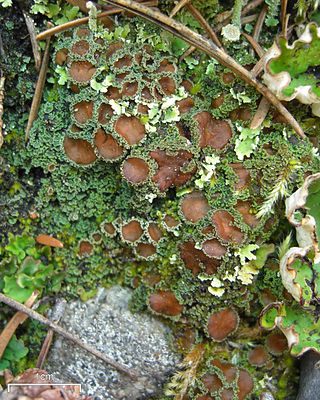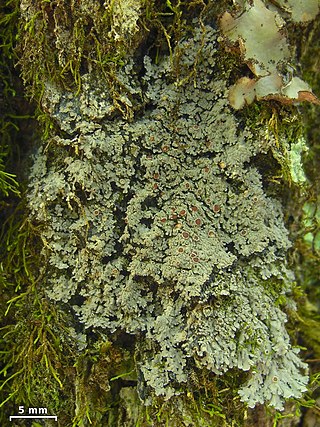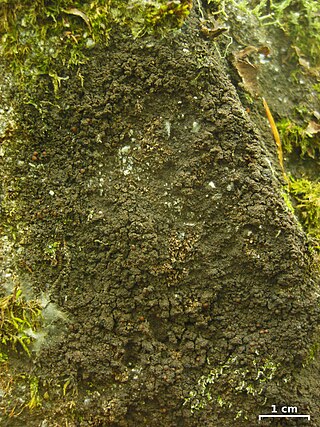
The Pannariaceae are a family of lichens in the order Peltigerales. Species from this family have a widespread distribution, but are especially prevalent in southern temperate regions.

Psoroma is a genus of lichen-forming fungi in the family Pannariaceae. The widespread genus contains about 30 species, most of which are found in south temperate regions.

Pannaria is a genus of lichen-forming fungi in the family Pannariaceae. The widespread genus contains an estimated 51 species, found primarily in tropical regions.

Fuscopannaria is a genus of lichen-forming fungi in the family Pannariaceae. It has 55 species.

Vahliella is a genus of nine species of lichen-forming fungi in the order Peltigerales. It is the only member of Vahliellaceae, a family circumscribed in 2010 to contain this genus. Vahliella was formerly placed in the family Pannariaceae until molecular phylogenetics showed that it did not belong there. Vahliella species are found in the Northern Hemisphere – mainly in North America, but also in Europe and India.
Rockefellera is a fungal genus in the family Pannariaceae. It is a monotypic genus, containing the single species Rockefellera crossophylla. The genus was circumscribed by James Lendemer and Erin Tripp in 2017. The generic name honors the Rockefeller family, "for their century-long support of North American conservation efforts, particularly with respect to national parks."
Steineropsis laceratula is a species of crustose placodioid lichen in the family Pannariaceae. It was first formally described in 1902 by French lichenologist Auguste-Marie Hue as Pannaria laceratula. Per Magnus Jørgensen proposed a transfer to Fuscopannaria in 1994. The taxon shuffled genera again in 2020 by Toby Spribille and Stefan Ekman after molecular phylogenetic analysis of the DNA from specimens collected in Alaska revealed its correct classification in the genus Steineropsis. The type specimen was collected in 1904 from Hakkoda, Japan, at an elevation of 1,200 m (3,900 ft); here the lichen was found growing on the bark of birch, but the species also grows on rock.
Fuscoderma papuanum is a species of squamulose (scaley) lichen in the family Pannariaceae. Endemic to Papua New Guinea, it was formally described as a new species in 2002 by lichenologists Per Magnus Jørgensen and Harrie Sipman. The type specimen was collected in Myola, in the Owen Stanley Range at an altitude between 2,400 and 2,800 m. Here, in the cool, moist habitat of a montane forest dominated by coniferous trees from the genera Phyllocladus and Podocarpus, it was found growing on a bank of the Iora Creek. It is similar to the type of genus Fuscoderma, F. applanatum, but is distinguished from that species by its smaller size, narrower, smooth lobes, and by the black rhizines on the thallus underside that, in young specimens, protrude out beyond the thallus.

Lepidocollema marianum is a species of cyanolichen in the family Pannariaceae. It was first scientifically described by Elias Fries in 1825 as Parmelia mariana. Per Magnus Jørgensen transferred it to the genus Lepidocollema in 2014 following a molecular phylogenetics-guided revision of the Pannariaceae.
Fuscopannaria obtegens is a species of corticolous (bark-dwelling), squamulose lichen in the family Pannariaceae. Found in China, it was formally described as a new species in 2007 by Norwegian lichenologist Per Magnus Jørgensen. The type specimen was collected from Nyingchi-Dongjuk at an elevation of 4,430 m (14,530 ft); there, on a south-facing slope, it was found growing on the stems of Juniper. It is only known to occur in the type locality. The widely spread thallus of the lichen is made of dichotomously branched, brown squamules up to 2 mm (0.08 in) in diameter. The squamules are imbricating, meaning they overlap each other; according to the author, they give the impression of a tiled roof reminiscent of stave churches in Norway.
Fuscopannaria hirsuta is a species of squamulose (scaley), corticolous (bark-dwelling) lichen in the family Pannariaceae. Found in China, it was formally described as a new species in 2004 by Norwegian lichenologist Per Magnus Jørgensen. The type specimen was collected from the Nyenchen Tanglha Mountains in Tibet at an elevation of 2,500 m (8,200 ft), where it was found growing on Salix bark. It has also been recorded growing on Juniperus bark. The species epithet hirsuta refers to the hairy upper thallus surface, the first in genus Fuscopannaria with this characteristic.
Fuscopannaria granulifera is a species of squamulose (scaley), corticolous (bark-dwelling) lichen in the family Pannariaceae. Found in India, it was formally described as a new species in 2004 by Norwegian lichenologist Per Magnus Jørgensen. The type specimen was collected from the Great Himalayan National Park at an elevation of 3,140 m (10,300 ft). It is only known to occur in the upper forests of western Himalayas. F. granulifera is the only corticolous member of its genus that has a green algal photobiont; all others have a cyanobacterial photobiont.
Fuscopannaria dispersa is a species of corticolous (bark-dwelling), squamulose lichen in the family Pannariaceae. It is found in China, where it grows on the bark of several tree species at an elevation range from 3,650 to 4,300 m, close to the forest limit. It was formally described as a new species in 2000 by Norwegian lichenologist Per Magnus Jørgensen. The type specimen was collected by Joseph Rock from the eastern slopes of Likang Snow Range in 1922, and has since been documented in a few locations in eastern China. The lichen has a brown thallus made of small squamules spread out over a distinct black prothallus. Its ascospores are ellipsoid, colourless, lack septa, and measure 15–17 by 9–10 μm. Fuscopannaria dispersa is similar to the more widespread F. leucosticta, but can be distinguished from that species by the squamulose form of its thallus and by its smaller, rounder ascospores.
Fuscopannaria dissecta is a species of corticolous (bark-dwelling), squamulose lichen in the family Pannariaceae. Found in Japan, it was formally described as a new species in 2000 by Norwegian lichenologist Per Magnus Jørgensen. The type specimen was collected by Syo Kurokawa from Mount Kōya at an altitude of 800 m (2,600 ft); there it was found growing on the rotting bark of trees. The lichen has a pale brown thallus that forms irregular patches comprising squamules that about are about 2 mm wide. The squamules are dissected–cut deeply into fine lobes–and it is this character that is referenced in the species epithet dissecta.
Fuscopannaria saltuensis is a species of ground-dwelling, squamulose lichen in the family Pannariaceae. It is found in both the Eastern and Western Himalayas, where it grows on soil in open mountain forests with pastures and cliffs.
Fuscopannaria siamensis is a species of lichen in the family Pannariaceae. It is found in the mountainous forests of northern Thailand and in Tamil Nadu, India, where it grows in humid habitats in association with mosses.
Pannaria emodii is a species of corticolous (bark-dwelling), squamulose (scaley) to foliose (leafy) lichen in the family Pannariaceae. It was formally described as a new species in 2001 by the Norwegian lichenologist Per Magnus Jørgensen. The type specimen was collected in 1967 by Hiroshi Harada and colleagues from Shodu-Barshong (Bhutan) at an altitude between 3,500 and 3,800 m.
Pannaria complanata is a species of corticolous (bark-dwelling), squamulose (scaley) to foliose (leafy) lichen in the family Pannariaceae. It was formally described as a new species in 2001 by the Norwegian lichenologist Per Magnus Jørgensen. The type specimen was collected from the Doddabetta peak in the Nilgiri Mountains at an altitude of about 3,000 m (9,800 ft). The lichen makes circular patches typically up to about 5 cm (2 in) in diameter, comprising brownish, flat lobes measuring up to 2 mm wide. The photobiont partner is a member of the cyanobacterial genus Nostoc. The PD+ (orange) chemical spot test reaction indicates the presence of pannarin, a lichen product. The geographic range of the lichen includes India, Sri Lanka, and Indonesia. In India it is found only in the Western Ghats, having been recorded from Kerala and Tamil Nadu. In this country Pannaria complanata often associates with moss genus Hyophila.
Pannaria ramulosa is a species of corticolous (bark-dwelling), squamulose (scaly) to foliose (leafy) lichen in the family Pannariaceae. It was formally described as a new species in 2001 by the Norwegian lichenologist Per Magnus Jørgensen. Gustaf Einar Du Rietz collected the type specimen in 1927 from the Goenoeng Ardjoena. This rainforest lichen has a rounded thallus up to 5 cm (2 in) in diameter with thin, brownish lobes. It does not show any reactions to standard chemical spot tests, and no lichen products were detected using thin-layer chromatography. At the time of its original publication it was only known to occur at the type locality.
Pannaria formosana is a species of corticolous (bark-dwelling), squamulose (scaley) to foliose (leafy) lichen in the family Pannariaceae. Found in eastern Asia, it was formally described as a new species in 2001 by the Norwegian lichenologist Per Magnus Jørgensen. The type specimen was collected in February, 1965 by Syo Kurokawa from Chinsueiin Pass,.





